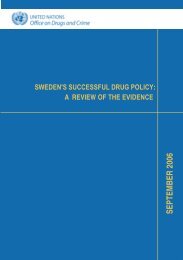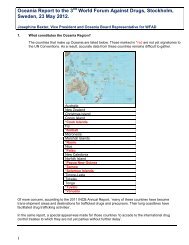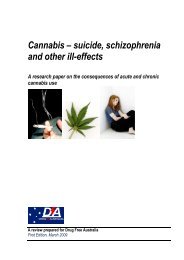International Research Compendium - Drug Free Australia
International Research Compendium - Drug Free Australia
International Research Compendium - Drug Free Australia
Create successful ePaper yourself
Turn your PDF publications into a flip-book with our unique Google optimized e-Paper software.
A consequence of long term marijuana use is the dependence on the psychoactive<br />
effects of THC and a withdrawal syndrome on cessation of use. A distinctive<br />
marijuana withdrawal syndrome including restlessness, irritability, mild agitation,<br />
insomnia, sleep disturbance, nausea and cramping has been identified, but it is<br />
relatively mild and short-lived.<br />
Marijuana addictions are increasing<br />
Today’s cannabis is 5 to 10 times as strong as it was in the 1970s.<br />
The number of adults using marijuana in the U.S. had remained the same between<br />
1992 and 2002, but the number of adults addicted to the drug had increased 25%.<br />
The 2002 DAWN<br />
survey showed a dramatic increase in marijuana-related hospital emergency room<br />
visits. Data showed that in 1992 there were 45 treatment admissions for marijuana<br />
use per 100.000 people aged 12 or older. This number more than doubled to 93<br />
admissions by 1997 and in 2002 was 118. Marijuana use also leads to more<br />
teenagers entering drug treatment in the U.S. than does the use of all other drugs<br />
combined, including alcohol.<br />
Early use and positive experiences in early use increase the risk for cannabis<br />
dependence.<br />
Once they’re dependent, teens often tumble into truancy, crime and depression.<br />
They can’t concentrate. They don’t go to school. They get totally detached from life.<br />
Because marijuana distorts perception, impairs judgement and verbal skills,<br />
compromises the ability to learn and remember information, induces memory loss<br />
and causes attention deficits, the more a person uses marijuana, the more he or she<br />
is likely to fall behind in performing an intellectual job or social skills.<br />
Marijuana use increases tendencies toward stealing, fighting en violence.<br />
Marijuana use contributes to risky sexual behaviours that increase the likelihood of<br />
disease and unwanted pregnancies.<br />
Exposure to cannabis in the womb could cause children to experience learning<br />
difficulties and hyper reactivity.<br />
Cocaine<br />
Cocaine blocks the reuptake of dopamine by the neurons that originally released it.<br />
Cocaine binds to the dopamine transporters. In this way, cocaine blocks its ability to<br />
transport dopamine from the synapse. This prevents the axon terminals from<br />
retrieving dopamine from the synapse. Dopamine is now trapped in the synapse,<br />
stimulates and restimulates dopamine receptors.<br />
A run of cocaine use ends with a reversal of the user’s initial experience: euphoria is<br />
followed by depression, energy by exhaustion, pleasure by malaise. Cocaine users<br />
not only feel terrible after a run of cocaine use, they find they are unable to<br />
experience life’s normal pleasures. Their brain’s pleasure system has been<br />
overstimulated and exhausted by cocaine use, which is a depletion of dopamine. The<br />
brain requires weeks or even months to re-establish a normal equilibrium in the<br />
synapses of the dopamine transmitting neurons, and there is a risk of producing a<br />
lifelong state of diminished ability to experience normal pleasures.<br />
Structural changes in neurons have also been seen following sensitisation to<br />
cocaine, such as a marked increase in the number of dendritic spines of the neurons<br />
of the Nuc. Accumbens and the prefrontal cortex.<br />
33






